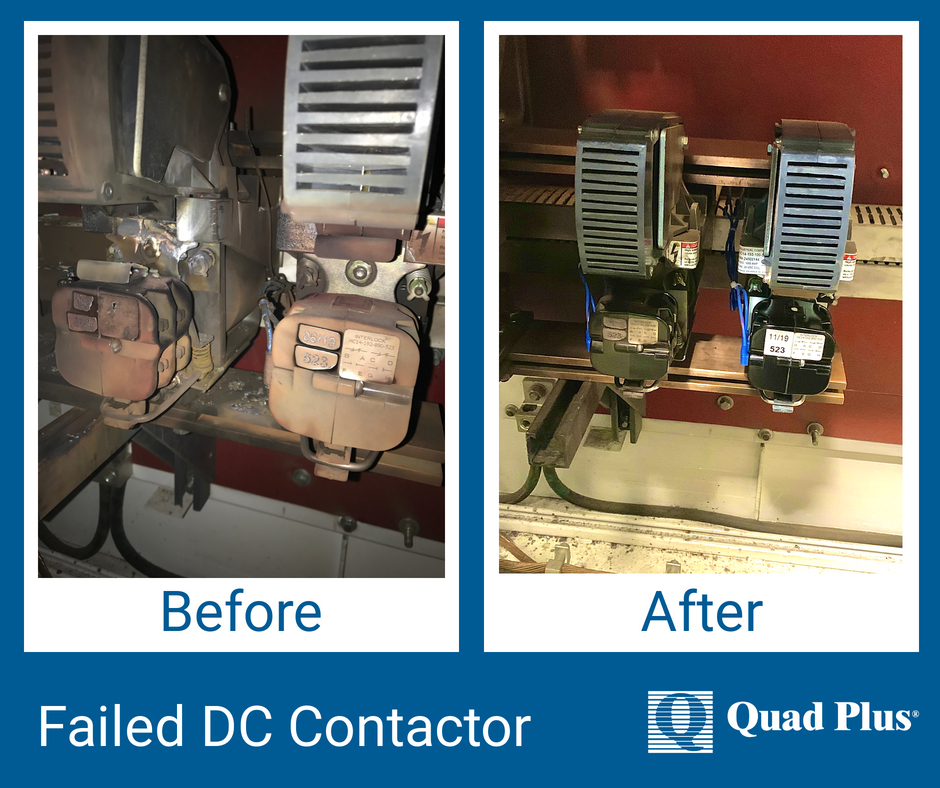Expertise Needed for Repeat DC Contactor Failure
April 6, 2021
We recently received a call from a customer regarding the failure of a DC contactor that Quad Plus replaced less than a month prior to this call. Our industrial repair team was dispatched to the site to perform a post-failure analysis to determine why the contactor failed again and how to resolve the issue for the customer permanently.
Background Information
In December of 2019, the Quad Plus Large Drive Division performed an emergency service on a large drive system at a customer’s metal recycling facility. A few weeks later, the customer called again to report a similar failure had occurred: a part that was replaced in the previous service call failed. We asked the customer what led up to the failure, and the customer explained that it failed shortly after a stop command was issued. This shifted our focus to the field circuit of the motor, specifically the logic.
Upon arrival at the second service call, we inspected what was left of the components previously installed by Quad Plus and found no issue or defects aside from the damage from the arc. We replaced the DC contactor and all the ancillary wiring within the circuit and verified its functionality via PLC control. Once verified, we began to focus on the field supply to determine if there was an issue.
What We Found
The first discovery was that the field supply had been misconfigured (by others) for the application. We reconfigured the field supply for the desired application and then quickly discovered that the field supply was, in fact, faulty and in need of replacement.
Upon inspection of the inboard motor, the Large Drive Team found substantial amounts of dirt and debris, along with multiple arc marks from the previous DC contactor failures. The motor inspection also revealed that many of the carbon brushes were seized in the brush boxes, brush arms (constant tension EMD arm) were covered in brass and copper slag, and the commutator surface had a heavy film on it as well. The brush springs were found to have insufficient tension, and questionably low megger readings from previous measurements needed attention.

Our Resolution
The first issue to address was the faulty field supply. The customer had a spare supply on the shelf, so we were able to quickly swap the devices out. Once the replacement supply was installed, the system ran smoothly. Therefore, we determined that the faulty field supply was, in fact, the root cause of the repeated DC contactors failure, and we are confident that the customer will not experience another repeat of this specific failure.
The next issue to address was the condition of the motor. With the customer’s approval, we began by isolating the motor electrically from the system. We then removed all the brushes, brush arms, and springs from the motor. The motor was thoroughly cleaned with dry compressed air and abrasive to remove all remaining residue from the flashovers and the commutator film. With the motor now clean of all visible contaminates, we masked off all critical connections and applied red insulating varnish to the commutator riser, v-band, and the brush arm connection points.
All the brush arms were thoroughly cleaned with solvent and filed to remove sharp edges and burrs. The arms, brushes, and brush springs were then reinstalled as per industry standards. The motor was megger tested to ensure there was no pathway to the ground, and the insulation was within known industry standards. Lastly, electrical connections were reinstalled and torqued per NFPA70e.
Testing & Verification
The final findings of the Large Drive Division were that the faulty field supply was the root cause of the DC contactor failure. Once that part was replaced, our team also discovered problems with the motor, including evidence of extensive arcing and a considerable amount of debris buildup. Brushes, arms, and springs were cleaned, replaced, and properly tensioned. At this point, we were ready to test the entire system to ensure production for the customer.
We tested by performing multiple controlled starts and stops to see if we could recreate a failure with the DC contactor without issue. The system was then placed into full production and observed for approximately eight hours without issues.
Our Promise
The customer’s initial question with the second call for the DC contactor failure was whether this was subject to warranty. We always stand behind our repair and replacement work, so our customers are confident when choosing our industrial repair services. Upon further inspection of the customer’s system, we found evidence that multiple arc events were undiscovered with the first visit in December and would have necessitated a further inspection of the system had we been aware at that time. Instead, we simply replaced the faulty part.
Because the Large Drive Division was called out a second time for the same part in such a short period of time, we were compelled to do a more thorough inspection, and this is where we discovered a history of failures on the DC contactor circuit. While this did result in the DC contactor replacement not being subject to a warranty replacement, the customer was very pleased with our service as we were able to get to the root of the problem and prevent further downtime. The customer commented that it was reassuring to have companies like us willing to go the extra mile to ensure proper operation.
We also discovered at a later date that the customer had some bad wiring locally that was also contributing to the problem. We were able to troubleshoot and resolve this issue remotely, and in over two years, the customer has not had any additional problems. Our customer is happy, and we met our goal of another satisfied Quad Plus customer.






